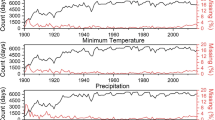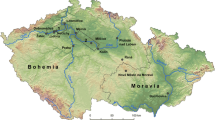Abstract
Long term (100 yr) trends of 17 selected annual climatic parameters were studied for 5 locations in Canada. Simple linear correlation coefficients (r) were computed for each variable with time. Temporal variations were not uniform over space, as might be expected over a large continent. Some variables differed significantly with time, while others did not. Forage aridity indices (FAI), or seasonal forage water deficits, had significant negativer values at Agassiz and Ottawa, indicating decreasing aridity over time, but no such trends were evident at the other 3 locations. Stations in western Canada were characterized byr values (mostly significant atP = 0.01) which indicated trends to earlier last spring frost (SF), later growing season end (GSE), later first fall frosts (FF) and increased frost-free period (FFP), growing degree-days (GDD) and Corn Heat Units (CHU). Stations in eastern Canada did not exhibit the same warming trends. No warming trends were observed in January mean temperature (JAN).
Five-year moving averages and standard deviations were calculated and plotted forFAI, FF, GDD andGSL (growing season length). The climatic attributes were extremely variable, making detection of warming or cooling trends difficult. TheFAI for the last 30 yr or more at Agassiz and for the last 20 yr at Ottawa was well below the 100 yr normal. At Indian Head,FAI values were high during the 1930's and again around 1960, reflecting the drought conditions which occurred at those times. The other 3 variables showed a tendency to slightly increasing values over the past 50 yr at Agassiz, Indian Head, Brandon and Ottawa. Little, if any, systematic change in these elements was evident at Charlottetown. Standard deviations (S d) fluctuated widely at all locations, with generally little evidence to suggest that the climate has become more or less variable. Cumulative frequency distribution for the total period and the first 70 yr were compared to the last 30 yr. There was an increased frequency of lowerFAI values at 2 locations for the 30-yr period.GDD increased significantly at lower probabilities at Indian Head. Differences in frequency distributions were generally slight for all other variables at the 5 locations.
Similar content being viewed by others
References
Baier, W.: 1971, ‘Evaluation of Latent Evaporation Estimates and Their Conversion to Potential Evaporation’,Can. J. Plant Sci. 51, 255–266.
Baier, W. and Robertson, G. W.: 1965, ‘Estimation of Latent Evaporation from Simple Weather Observations’,Can. J. Plant Sci. 45, 276–284.
Baier, W., Dyer, J. A. and Sharp, W. R.: 1979, ‘The Versatile Soil Moisture Budget’, Tech. Bull. 87, Agrometeorol. Sect., Research Branch, Agriculture Canada, Ottawa, 51 pp.
Balling, Jr., R. C. and Idso, S. B.: 1990, ‘Effects of Greenhouse Warming on Maximum Summer Temperatures’,Agric. Forest Meteorol. 53, 143–147.
Barnett, T. P. and Schlesinger, M. E.: 1987, ‘Detecting Changes in Global Climates Induced by Greenhouse Gases’,J. Geophys. Res. 92, 14772–14780.
Berry, M. O.: 1991, ‘Recent Temperature Trends in Canada’,Operat. Geogr. 9, 9–13.
Brown, D. M.: 1975, ‘Heat Units for Corn in Southern Ontario’, Ontario Ministry of Agriculture and Food, Factsheet 75-077, 4 pp.
Boer, G. J.: 1990, ‘Results from a 2 × CO2 Simulation with the Canadian Climate Centre General Circulation Model’, in Wall, G. and Sanderson, M. (eds.),Climate Change Implications for Water and Ecological Resources, Proceedings of an International Symposium/Workshop, sponsored by The Water Network, Canadian Climate Centre, Environment Canada, Sustainable Development Branch, Canada Committee on Ecological Land Classification, the Grand River Conservation Authority, pp. 45-49.
Bootsma, A.: 1976, ‘A Note on Minimum Temperature and the Climatological Day at First Order Stations’,Atmosphere 14, 53–55.
Dominion Bureau of Statistics: 1964,Handbook of Agricultural Statistics, Part I: Field Crops, 1908–1963, Crops Section, Agricultural Division, Dominion Bureau of Statistics, Ottawa, Canada, 187 pp.
Hansen, J. and Lebedeff, S.: 1987, ‘Global Trends of Measured Surface Air Temperature’,J. Geophys. Res. 92, 13,345–13,372.
Hanson, K., Maul, G. A. and Karl, T. R.: 1989, ‘Are Atmospheric “Greenhouse” Effects Apparent in the Climatic Record of the Contiguous U.S. (1895–1987)’,Geophysical Res. Lett. 16 (1, 49–52.
Hengeveld, H.: 1991, ‘Understanding Atmospheric Change’, A State of the Environment Report No. 91-2, Atmospheric Environment Service, Environment Canada, p. 34.
Idso, S. B. and Balling, Jr., R. C.: 1992, ‘U.S. Temperature/Precipitation Relationships: Implications for Future “Greenhouse” Climates’,Agric. For. Meteorol. 58, 143–147.
Jones, P. D., Raper, S., Bradley, R., Diaz, H., Kelly, P., and Wigley, T.: 1986a, ‘Northern Hemisphere Surface Air Temperature Variations: 1851–1984’,J. Clim. Appl. Meteorol. 25, 161–179.
Jones, P. D., Wigley, T. M. L., and Wright, P. B.: 1986b, ‘Global Temperature Variations between 1861 and 1984’,Nature 322, 430–434.
Karl, T. R. and Jones, P. D.: 1989, ‘Urban Bias in Area-Averaged Surface Temperature Trends’,Bull. Amer. Meteorol. Soc. 70(3, 265–270.
Karl, T. R., Diaz, H. F., and Kukla, G.: 1988, ‘Urbanization: Its Detection and Effect in the United States Climate Record’,J Clim. 1, 1099–1123.
Karl, T. R., Kukla, G., and Gavin, J.: 1984, ‘Decreasing Diurnal Temperature Range in the United States and Canada from 1941 through 1980’,J. Clim. Appl. Meteorol. 23, 1489–1504.
Madden, R. A. and Ramanathan, V.: 1980, ‘Detecting Climate Change due to Increasing Carbon Dioxide’,Science 209, 763–768.
Nkemdirim, L. C. and Venkatesan, D.: 1985, ‘An Urban Impact Model for Changes in the Length of Frost Free Season at Selected Canadian Stations’,Clim. Change 7, 343–362.
Parker, D. E.: 1985, ‘On the Detection of Temperature Changes Induced by Increasing Atmospheric Carbon Dioxide’,Q. J. R. Meteorol. Soc. 111, 587–601.
SAS Institute Inc.: 1985a, ‘SAS User's Guide: Basics, Version 5 Edition, SAS Institute Inc., Cary, N.C., 1290 pp.
SAS Institute Inc.: 1985b, ‘SAS User's Guide: Statistics, Version 5 Edition, SAS Institute Inc., Cary, N.C. 956 pp.
Schaal, L. A. and Dale, R. F.: 1977, ‘Time of Observation Bias and “Climatic Change”,J. Appl. Meteorol. 16, 215–222.
Shields, J. A. and Sly, W. K.: 1984, ‘Aridity Indices Derived from Soil and Climatic Parameters’, Agriculture Canada, Res. Branch, Tech. Bull. 1984-14E, Ottawa, Ont. 18 pp.
Statistics Canada, 1988, ‘Handbook of Field Crop Statistics, 1960–1986’, Crops Section, Agricultural Statistics Division, Statistics Canada, Ottawa, Ont.
Wigley, T. M. L. and Jones, P. D.: 1981, ‘Detecting CO2 Induced Climatic Change’,Nature 292, 205–208.
Author information
Authors and Affiliations
Rights and permissions
About this article
Cite this article
Bootsma, A. Long term (100 yr) climatic trends for agriculture at selected locations in Canada. Climatic Change 26, 65–88 (1994). https://doi.org/10.1007/BF01094009
Received:
Revised:
Issue Date:
DOI: https://doi.org/10.1007/BF01094009




